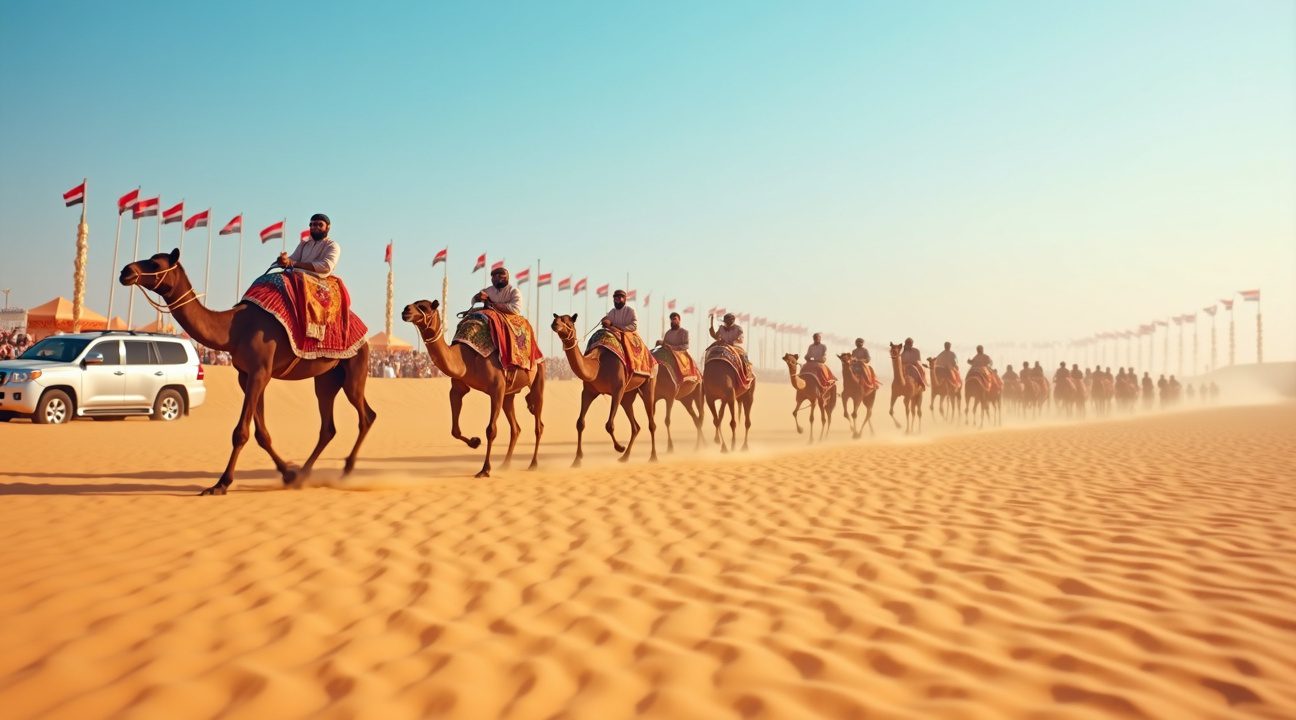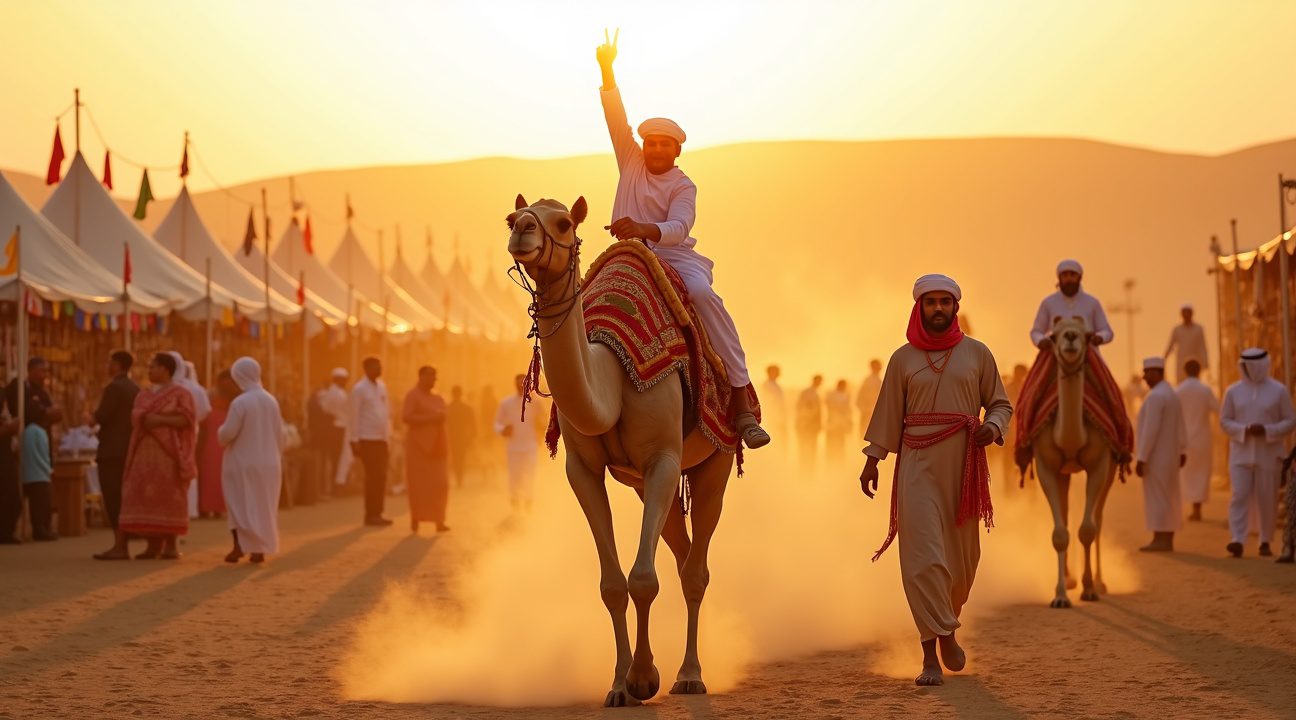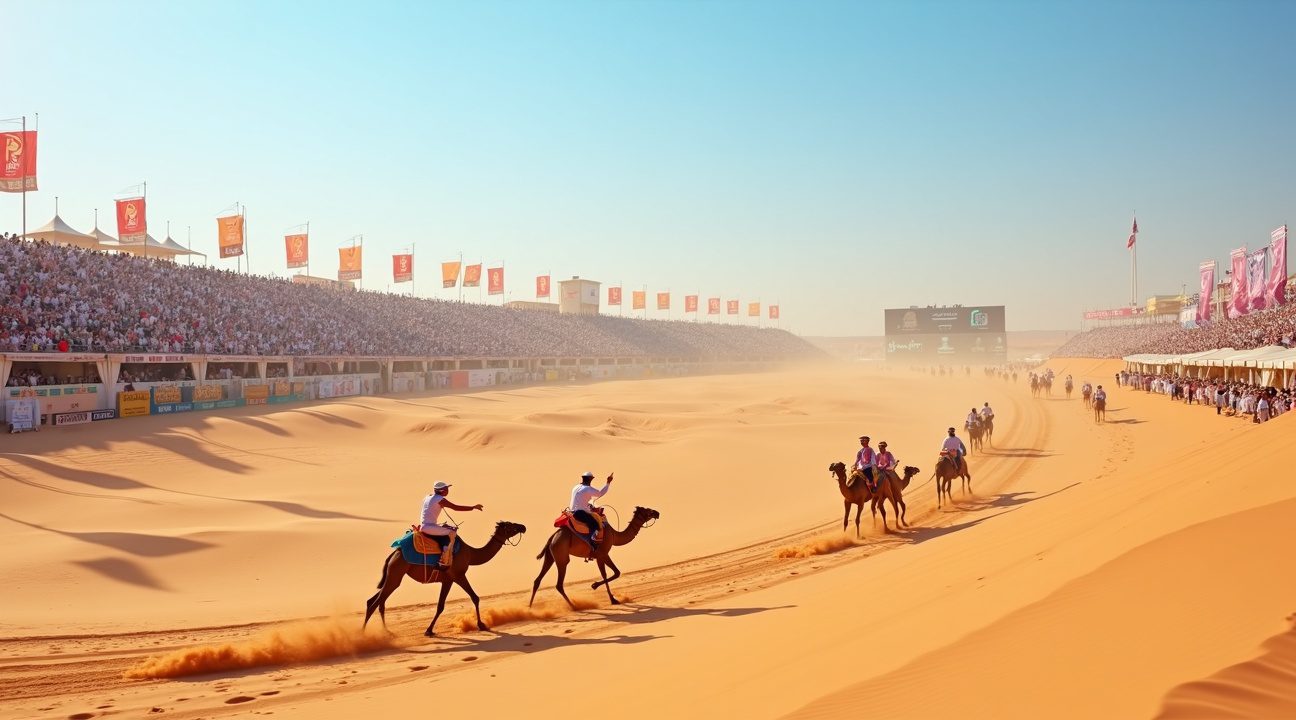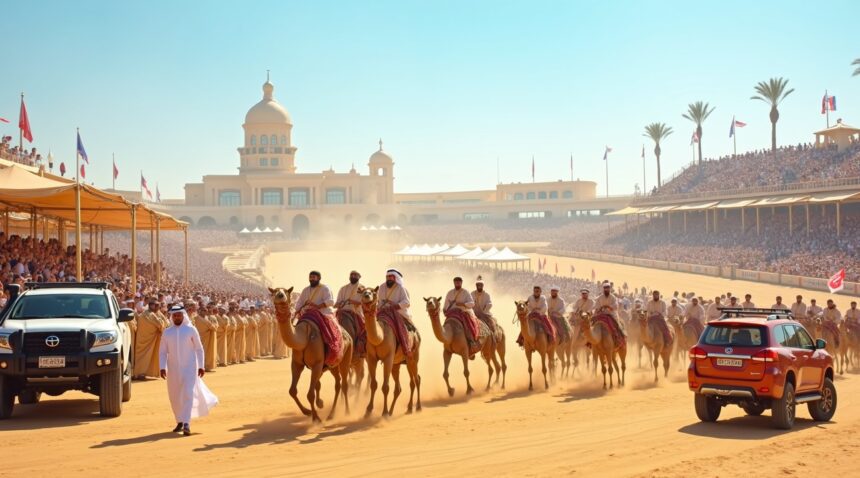The UAE’s premier camel racing festivals have transformed this ancient desert tradition into one of the globe’s highest-stakes sporting events, with the Al Marmoum Heritage Festival offering record-breaking prize pools reaching Dh150 million ($40 million).
Key Takeaways
- Massive Prize Pools: Major UAE camel racing festivals offer prize pools exceeding Dh100–150 million, with individual championship races awarding up to Dh10 million to winners.
- Social Prestige: Victory brings significant social prestige and enhanced status within Emirati communities, opening doors to exclusive breeding contracts and profitable trading arrangements.
- International Participation: International competitions feature over 14,000 camels from Gulf countries competing across 300+ races in structured categories including juvenile, veteran, and marathon divisions.
- Rising Camel Values: Championship wins increase camel values by up to 300% in trading markets, creating lucrative breeding opportunities and long-term investment returns.
- Professionalization of the Sport: Recent events like the AlUla Camel Cup have set new standards with SR80 million prize pools, establishing camel racing as a professional sport rivaling major international competitions.
Record-Breaking Prize Pools Transform Desert Racing Into Million-Dirham Sport
I’ve witnessed the transformation of camel racing from a traditional desert pastime into a multi-million dirham sport that rivals any major international competition. The Al Marmoum Heritage Festival stands as the pinnacle of this evolution, offering prize pools that reach an astronomical Dh150 million—over $40 million—making it the largest sporting purse in the region.
The scale of these competitions demonstrates just how seriously the UAE takes this ancient sport. The Sheikh Hamdan bin Mohammed Festival, hosted annually at Dubai’s prestigious Al Marmoom racetrack, distributes more than Dh100 million in prizes across various categories and races. Individual championship heats alone can award up to Dh10 million to the owners of the fastest camels, establishing camel racing as one of the highest-stakes sporting events in the Middle East.
Prize Distribution Creates Winners at Every Level
Prize structures in major UAE camel races ensure that participation pays off for multiple competitors. Races typically reward the top 10 finishers with cash prizes starting at Dh1,500 for those placing in the lower positions. However, the real excitement builds toward the top positions where luxury vehicles frequently complement substantial cash awards.
Winners across specific racing categories often receive prestigious items that reflect the cultural significance of the sport. These awards include:
- Luxury 4WDs
- Ornate trophies crafted by skilled artisans
- Symbolic ceremonial items such as rifles, spears, and daggers
These prizes honor the traditional heritage of desert life. The prize breakdowns reveal a careful balance between cash rewards and luxury items, emphasizing both the economic value and cultural importance of achievement in this sport.
Major Festival Comparisons Reveal Massive Investment
Comparing the two premier camel racing festivals illustrates the incredible financial commitment behind these events. The Al Marmoum Heritage Festival leads with its record-breaking Dh150 million overall prize pool, while the Dubai Camel Festival maintains its own impressive standard with awards exceeding Dh100 million. Both events demonstrate the UAE’s dedication to preserving and elevating traditional sports through substantial financial backing.
Heat winners across these festivals typically receive luxury vehicles such as:
- Nissan Patrols
- Toyota Land Cruisers
These vehicles are perfectly suited for the desert terrain where many camel owners spend their time. Overall event champions, however, receive the most coveted prizes:
- High-value cash awards—often reaching into the millions of dirhams
- Ceremonial gifts that carry deep cultural significance
The economic impact extends beyond individual prize winners. These massive prize pools attract international attention and participation, bringing together the world’s finest racing camels and their owners. Some events generate excitement similar to major sporting contracts, creating a spectacle that combines tradition with modern entertainment value.
Prize money distribution strategies also reflect careful planning to maintain competitive balance. Lower-tier awards ensure emerging competitors stay motivated, while the top prizes create life-changing opportunities for those with championship-caliber animals. The structure encourages both seasoned professionals and newcomers to invest in quality camels and training programs.
The financial success of these events has created a ripple effect throughout the camel racing industry. Training facilities, veterinary services, and breeding programs all benefit from the increased investment flowing into the sport. Prize money has effectively transformed camel racing from a cultural tradition into a serious economic venture where strategic investments in animals, training, and facilities can yield substantial returns.
These record-breaking prize pools have elevated camel racing to unprecedented heights, creating opportunities for owners to earn returns that rival investments in other major sports. The combination of substantial cash prizes and luxury awards ensures that success in UAE camel racing brings both financial rewards and lasting prestige within the community.

Prestige and Social Status Drive Owners Beyond Financial Rewards
I’ve witnessed firsthand how winning a major camel race transforms an owner’s standing within Emirati society. The financial rewards, while substantial, represent only one dimension of success in this deeply cultural sport. Social prestige becomes the true prize that extends far beyond the immediate monetary gains.
Champion camel owners find themselves elevated to an elite tier within their communities. This enhanced status opens doors to exclusive breeding contracts and creates opportunities for profitable trading arrangements that weren’t previously available. Fellow enthusiasts seek out these successful owners, eager to negotiate partnerships or acquire offspring from proven bloodlines.
Cultural Significance and Festival Recognition
The sport maintains its roots in Emirati heritage, particularly during prestigious events like the Crown Prince of Dubai Festival. I’ve observed how victories during these celebrations carry additional weight, as they occur under the scrutiny of royal patronage and national attention. Winners receive recognition that connects their personal achievements to broader cultural traditions.
Coveted honors distinguish the most successful participants from casual competitors. These prestigious awards include:
- The Golden Sword, representing excellence in competitive racing
- The Crown Prince Sword, signifying royal recognition and approval
- Festival-specific trophies that commemorate participation in heritage celebrations
- Regional championship awards that establish dominance across multiple racing circuits
High-profile social events follow major race victories, creating networking opportunities that extend an owner’s influence. These gatherings serve as platforms for discussing future breeding arrangements, establishing new partnerships, and sharing knowledge about training techniques. Heritage village activities often celebrate winners, reinforcing the connection between individual success and national pride.
Post-race trading activity reflects these enhanced social positions immediately. Winners frequently revise their herd valuations upward, capitalizing on their newfound prestige to command premium prices. Breeding contracts become more lucrative as other owners seek to associate their bloodlines with proven champions. The ripple effects of a single major victory can influence an owner’s business prospects for years.
I’ve noticed how massive deals in other sports often mirror the prestige-driven nature of camel racing success. Both scenarios demonstrate how achievement transcends immediate financial returns, creating long-term value through enhanced reputation and expanded opportunities. The social capital gained from racing victories enables owners to participate in exclusive circles previously beyond their reach.
Royal patronage adds another layer of distinction to successful owners. Those who catch the attention of ruling families through exceptional performance often find themselves invited to private events and consultations. This royal recognition can lead to advisory roles in racing development or participation in cultural preservation initiatives.
The breeding market responds directly to these status changes. Successful owners discover that their camels’ offspring command higher prices even before proving themselves competitively. Buyers recognize the value of bloodlines associated with champion animals and prestigious owners. This creates a sustainable cycle where social status translates into ongoing financial benefits.
Trading relationships evolve as winners gain credibility within the racing community. Previously hesitant sellers become eager to conduct business with proven successful owners. International buyers specifically seek out camels from UAE champions, understanding that the prestige transfers across borders and enhances their own standing in global racing circuits.
These social dynamics extend beyond individual success to family legacy. Winning owners often establish multi-generational racing programs that maintain their elevated status across decades. Children and grandchildren inherit not just valuable animals but also the social connections and reputation that enable continued success in the sport.
International Competition Features Thousands of Camels Across Multiple Categories
Camel racing festivals across the UAE showcase an extraordinary scale of competition that draws participants from throughout the Gulf region and beyond. Events at premier venues like Al Marmoom and Dubai’s racetracks regularly feature over 14,000 camels competing across 300 to 359 individual races during multi-day festivals. Countries including Saudi Arabia, Kuwait, and Oman send their finest racing camels, creating truly international competitions that celebrate this cherished regional tradition.
Structured Categories Ensure Fair Competition
Race organizers carefully structure competitions to ensure fair matchups between animals of similar capabilities and characteristics. Key categories include:
- Juvenile camel races for younger animals learning the sport
- Veteran competitions featuring experienced racing camels
- Special divisions for top-performing female camels aged six years and older
- Marathon contests stretching up to 25 kilometers for endurance specialists
- Separate classifications distinguishing privately owned camels from those belonging to sheikhs
- Championship finals that crown the festival’s ultimate winners
Event schedules typically begin in early morning hours and continue through late evening, accommodating the large number of races while providing optimal racing conditions. This extended timeline allows spectators to witness multiple categories throughout the day while maintaining the animals’ well-being in the desert climate.
Festival organizers frequently publicize champion camel names alongside their national affiliations, celebrating both the animals and their countries of origin. These announcements build excitement among the tens of thousands of spectators who regularly attend major racing festivals. The international nature of these competitions has grown significantly, with major sporting events drawing global attention to traditional Gulf pastimes.
Family-friendly environments characterize these festivals, with organizers creating comprehensive entertainment experiences beyond the races themselves. Cultural activities, traditional food stalls, and community engagement opportunities transform racing venues into celebration spaces that welcome all ages. Parents often bring children to experience this important cultural tradition firsthand, ensuring its continuation across generations.
Dubai’s racing facilities typically attract slightly larger crowds compared to Al Marmoom, though both venues maintain similar structures for scheduling and race lengths. The consistency between venues helps standardize competition formats while allowing each location to develop its unique character and specialties.
Marathon races represent some of the most challenging and prestigious competitions within these festivals. Covering distances up to 25 kilometers, these endurance tests separate exceptional racing camels from merely good ones. Owners invest substantial resources in conditioning their animals for these demanding events, knowing that victory brings both financial rewards and lasting prestige.
The distinction between privately owned and sheikh-owned camels creates multiple competitive levels within festivals. This classification system ensures that private owners can compete meaningfully while acknowledging the significant resources that royal and noble families typically invest in their racing programs. Both categories maintain high competitive standards and draw serious international participation.
Attendance figures reaching tens of thousands demonstrate the enduring popularity of camel racing throughout the region. These numbers reflect not just casual interest but genuine passion for a sport that connects modern UAE culture with its Bedouin heritage. International visitors often express amazement at the scale and organization of these events, recognizing them as world-class sporting competitions rather than simple cultural exhibitions.
The structured approach to categorization and scheduling allows organizers to accommodate the massive scale of these festivals while maintaining competitive integrity. With hundreds of individual races occurring over several days, precise organization becomes essential for ensuring fair competition and optimal spectator experiences. This systematic approach has helped UAE camel racing festivals establish themselves as premier international sporting events that attract significant attention and investment from across the Gulf region and beyond.
Economic Benefits Extend Beyond Prize Money to Breeding and Trading Markets
Winning a major camel race transforms the economic value of both the victorious animal and its entire bloodline. I’ve observed how prize-winning camels command significantly higher prices in post-race trading markets, with championship victories often triggering immediate interest from collectors and breeders across the Middle East. The prestige associated with these wins creates a ripple effect that extends far beyond the initial prize money distribution.
Market Transformation and Investment Opportunities
The commercial impact becomes particularly evident in breeding operations, where successful bloodlines develop premium status among buyers. Comparative data reveals that championship-winning camels experience price increases of up to 300% in trading markets, making them highly sought-after investments. Breeding stock from victorious camels becomes especially lucrative, as buyers recognize the genetic potential for producing future champions.
Racing festivals themselves generate substantial economic activity through their associated cultural markets and heritage villages. These events feature artisan showcases that display traditional handicrafts, creating seasonal income opportunities for local vendors. Popular market items include:
- Ornate textiles
- Custom leather goods
- Specialized saddlery
- Decoratively crafted camel equipment
These goods appeal to both participants and tourists.
Cultural exhibitions accompanying these festivals incorporate traditional music and dance performances, which draw tourism revenue and stimulate local economies. The combination of sporting excitement and cultural heritage creates a unique economic ecosystem that benefits multiple stakeholder groups. Vendors report increased sales during racing seasons, particularly for items connected to traditional sporting culture and regional heritage.
Investment patterns show increased interest from buyers across the region following major race victories. The heightened value of racing stock creates opportunities for owners to reinvest winnings into expanding their operations or acquiring additional premium animals. This cycle of investment and return reinforces camel racing’s position as both a cultural tradition and a viable commercial enterprise, much like how other high-stakes competitions generate economic activity beyond their immediate outcomes.
The economic benefits demonstrate how camel racing functions as a commercial and cultural pillar within UAE society, creating lasting value that extends well beyond the racetrack itself.

Recent Champions Set New Standards Across Regional Racing Circuit
The camel racing landscape has witnessed unprecedented prize levels that now rival major international sporting events. These substantial financial rewards reflect the sport’s evolution from traditional cultural practice to elite competitive racing that attracts global attention and investment.
Record-Breaking Prize Pools Transform Competition Standards
The AlUla Camel Cup has established itself as the pinnacle of financial achievement in camel racing. The second edition featured an extraordinary total prize pool of SR80 million (approximately $21 million), setting new benchmarks for the entire regional circuit. Major races within this prestigious event, including the Zmoul and Hail competitions, each offered SR7.5 million to first-place winners, creating incentives that have fundamentally changed how owners approach training and participation strategies.
Dubai’s racing calendar continues to showcase substantial rewards through events like the Crown Prince of Dubai Sword competition, which offers Dh3 million in recognition of top-performing female camels. This focus on celebrating both male and female camel achievements demonstrates the sport’s commitment to comprehensive excellence across all categories. The financial stakes involved have elevated preparation standards, with winning stables investing significantly in nutrition, training facilities, and expert care teams.
Championship Victories Create Lasting Legacies
Winning at these elite levels grants stables international recognition that extends far beyond prize money. Names like Hijin Alshahaneyah have become household references across regional sports media, representing the pinnacle of breeding and training excellence. These champions inspire new participants while reinforcing camel racing’s position within cultural identity and modern sporting achievement.
I’ve observed how recent champions consistently post remarkable race times while building notable legacies that receive prominent coverage in news reports. Dubai’s ambitious projects often mirror this same drive for excellence that defines championship camel racing. The comparative prize figures and finishing metrics serve as essential tools for tracking progression and measuring success across different venues and seasons.
The sporting excellence demonstrated by these champions has created ripple effects throughout the industry. Training methodologies have become more sophisticated, with successful stables sharing knowledge that elevates overall competition quality. Veterinary care has reached new standards as owners recognize that championship-level performance requires comprehensive animal welfare programs.
Legacy stories from prominent stables continue inspiring newcomers to enter the sport while attracting international investors who recognize the commercial potential of elite camel racing. These success narratives often feature multi-generational breeding programs where championship bloodlines command premium valuations and breeding fees.
The media coverage surrounding recent champions has amplified camel racing’s profile across traditional and digital platforms. Victory celebrations often feature elaborate ceremonies that showcase the cultural significance alongside sporting achievement, creating content that resonates with both local audiences and international observers interested in unique sporting traditions.
Prize distribution systems have also evolved to recognize achievements beyond first-place finishes, ensuring that competitive excellence receives appropriate rewards throughout the field. This approach maintains high participation levels while encouraging continued investment in quality animals and training programs that benefit the entire racing community.
Performance tracking technology now enables detailed analysis of championship runs, providing data that helps identify trends and improvements across the sport. These insights contribute to better understanding of what separates elite performers from standard competitors, creating educational opportunities for aspiring owners and trainers.
The financial success of recent champions has established sustainable business models for professional camel racing operations. Prize money levels now support year-round training programs and facility investments that were previously impossible, creating professional pathways for individuals seeking careers within this specialized sporting industry.

Sources:
Arab News PK, “AlUla Camel Cup concludes with record prize money”
The National News, “Dubai camels compete for Dh100 million in cash at February festival”
Gulf News, “Record Dh150m prize money for Al Marmoum Festival”
Saudipedia, “Al-Ula Camel Cup”
GDN Life, “Arab Camel Racing Federation and the International Endurance Championship in AlUla”
Emirates Natural History Group, “Camel Racing in the Gulf”


